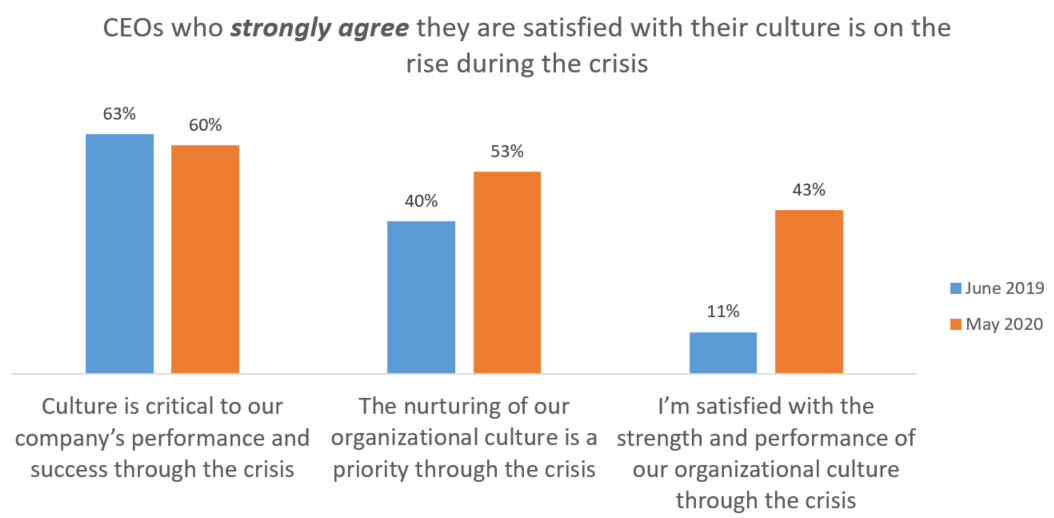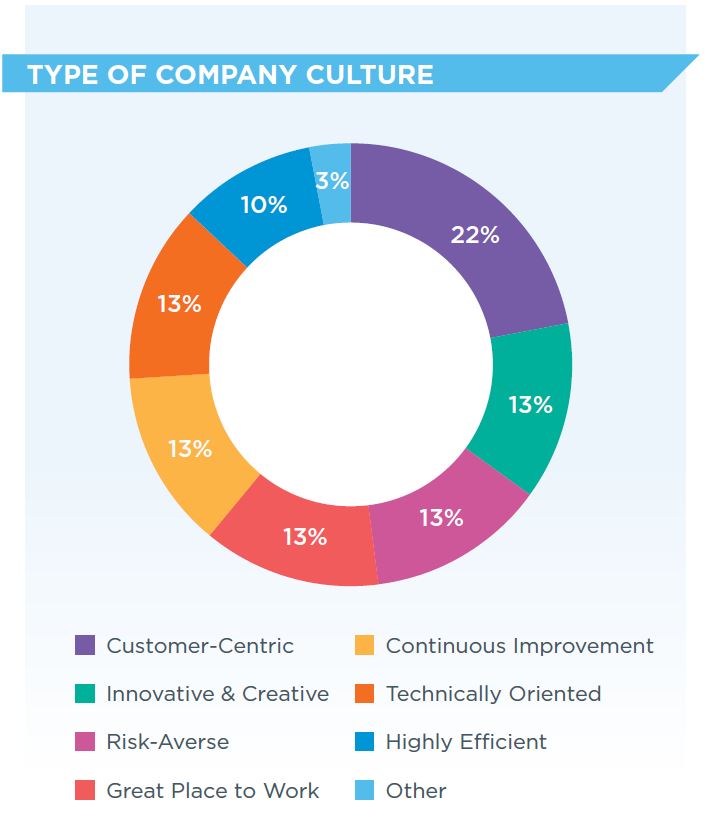Organizational Culture & Values
Leveraging your culture through crisis and beyond

According to new data from Vistage, a strong organizational culture has helped a large proportion of small and midsize businesses (SMBs) navigate changes caused by the pandemic.
In our May Vistage CEO Confidence Index survey, more than 1,400 CEOs shared insights about the role of culture during a crisis. The number of CEOs who reported they “strongly agree” they are satisfied with the strength and performance of their culture was four times higher than prior to the crisis. This suggests cultural investments made by SMBs before the pandemic are now helping these businesses through the crisis.

Last year, the National Center for the Middle Market (NCMM) conducted research in partnership with Grant Thornton and The Ohio State University to identify the different types of culture in companies. The researchers identified seven cultural types and evaluated the performance of companies identifying with those cultures.
“Culture is like personality: Each one is unique,” says Tom Stewart, Executive Director of NCMM. “That said, the majority of cultures exhibit a certain set of patterns that allow for categorization at a high level. A strong culture helps individuals and groups make decisions when the boss isn’t there to guide them.”
This is especially relevant today, as stay-at-home orders have made remote working more commonplace. A strong organizational culture has helped individuals working remotely make good decisions and maintain productivity.
The 7 types of culture
Each culture type has different defining characteristics, and those characteristics have impacted how companies have responded to the current crisis.
- Customer-Centric: Companies with this culture emphasize a customer-first approach to business. “This culture is built around the idea that the customer comes first,” says Stewart. “These companies always want to do what’s right for the customer.” In the crisis, customer-centric companies have reacted quickly to the changing needs of their customers.
- Innovative and Creative: Companies with this culture look for new ways to create value through new channels. “These companies are always bursting with ideas, energy and innovation,” says Stewart. Our May survey found that 48% of SMBs have changed products and services during the crisis; companies with innovative and creative cultures are readily driving and enabling these changes.

Source: National Center for the Middle Market High Performance Culture report, March 2019 - Risk-Averse: Companies with this culture focus on minimizing risk and avoiding situations that appear risky. “This culture sends the message: ‘Don’t get it wrong. Make sure you are correct,’” explains Stewart. In a post-Covid world, companies with this culture might focus on highly detailed plans, but the greater danger is a paralysis that stifles initiative at a time when it is extremely important. “In our research, the risk-averse cultures were overwhelmingly associated with poor performance, because they generally stifle initiative and are slow to change and adapt,” he says.
- Great Place to Work: Companies with this culture foster an employee-centric mentality to create a stimulating environment for workers. “This is a people-centric culture,” says Stewart. “It wants to make people feel like they’re taken care of. Management tries to send the message of ‘We want you to be happy here. We want you to grow. We want you to feel like this place is someplace where you can grow and call home forever.’” Since moving to remote work, people-centric companies have found ways to stay connected to employees through newsletters, virtual happy hours, daily huddles and other fun challenges.
- Continuous Improvement. Companies with this culture emphasize steady gains in customer offerings and company processes. “This culture is about getting better every day in every way,” says Stewart. “It send the message, ‘We are always improving things around here. If we did it this way on Monday, we’re going to get slightly better on Tuesday.’” During the pandemic, companies with a continuous-improvement culture have continually iterated how they do business to maintain operations and stay connected with customers.
- Technically Oriented: Companies with this culture focus on developing the highest-quality products and services through engineering of all kinds. “This culture is about making the best stuff,” says Stewart. “In this culture, the ‘gods’ are the engineers, scientists or people who are always coming up with the most sophisticated, advanced and beautifully engineered products.” During the transition to remote working, technically oriented companies used new collaboration tools with ease and re-engineered their internal processes using technology.
- Highly Efficient: Companies with this culture are dedicated to eliminating inefficiencies and staying lean. “This is a cost-conscious culture,” says Stewart. “But it’s not necessarily a penny-pinching culture. It sends the message: ‘We don’t waste a dime around here. Everyone flies coach. Everything is printed on two-sided paper.’” In the crisis, companies with highly efficient cultures have contained costs and identified ways to make processes more efficient for the long term.
The connection between culture, performance and strategy
While NCMM’s study found that some cultures correlated with higher performance and faster growth, “none of these cultures are necessarily bad,” says Stewart. “If I were running a nuclear power plant, having a risk-averse culture might be a really good thing. This is where culture connects to strategy.”
Companies may also exhibit more than one culture at the same time. “It is possible to ‘major’ in one culture and ‘minor’ in the other culture,” says Stewart. To determine which culture is most dominant in your firm, “think about who is a ‘hero’ or a ‘legend’ in your company. Is that person likely to be a scientist or engineer? Then you might have the Technically Oriented culture. Is this person a creative genius? Then you might have the Innovative & Creative culture. Is this person someone who makes us better every day? Then you might have the Continuous Improvement culture.”
If you are like the 53% of SMB leaders focused on nurturing your culture through this crisis, NCMM’s research might offer you new perspectives. Learn more about how to harness the power of culture and assess the strength of your culture with NCMM’s cultural assessment tool.
Category : Organizational Culture & Values

